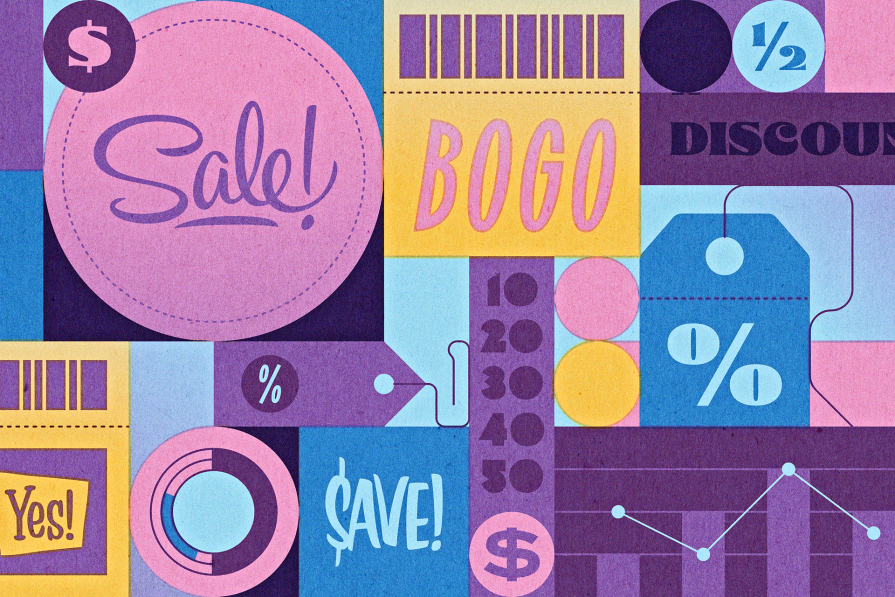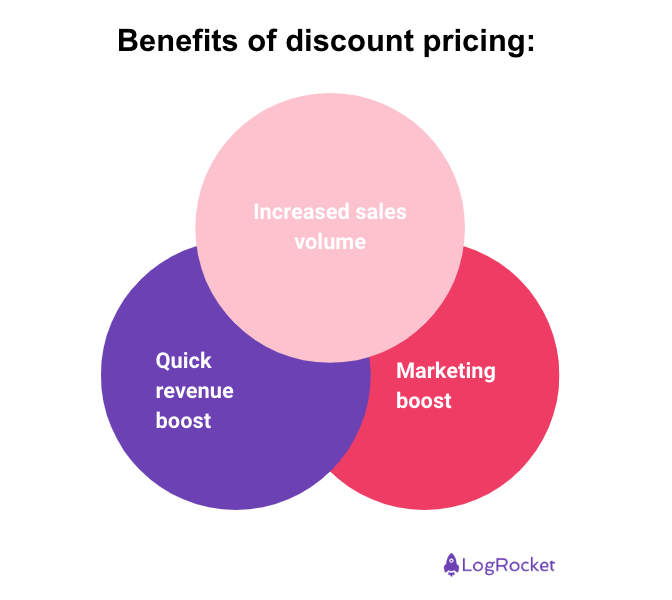Discounts are one of the oldest sales tactics out there. There’s just something about “saving X percent” that’s widely appealing to users, even when it means spending more money.

That said, discounts come with some serious caveats that, if left unmanaged, can do more harm than good in the long run. After a couple of years of working in monetization and CRO (conversion rate optimization), I finally figured out the difference between effective and ineffective discount strategies.
This article provides an overview of discount pricing strategy, including the benefits, caveats, and how to implement one within your product team.
A discount strategy is a playbook for how a company incorporates discounts throughout the year.
For example, Udemy’s discount strategy is to run 90 percent promotions all year round to boost overall cheapness.
On the other hand, most VPNs tend to run big promotions at particular times of the year, such as the Black Friday and Christmas discounts.
A well-thought discount strategy is a great addition to your overall monetization models.
Discounts reduce the long-term revenue you get from each sale, so why do so many products run them? A few main reasons include:

Discounts help you sell larger quantities of products.
If you have a physical product in stock, it’s a great way to get rid of overstocked products.
Digital products can benefit from increased sales volume. For example, if your growth is tied to the number of subscribers you have (e.g., viral growth model), boosting sales can actually help with long-term growth itself.
Even though discounts greatly reduce customers’ lifetime value, in the short run, they usually increase revenue thanks to increased sales volume.
It’s an effective way to get a quick cash boost when needed.
The marketing message is stronger if it comes with a discount.
Also, discounts help you open new promotional channels, such as influencer marketing.
Generally, marketers love incorporating discounts and coupons into their strategies.
The vast majority of caveats of discount strategies are rooted in two main problems — discount fatigue and discount blindness.
Each discount you offer lowers your price setpoint.
Let me explain it with an example.
If you have a product costing $100 and you run a 30 percent discount, people perceive it as a good deal. They “save” $30.
But then, if you run this discount regularly, people will start perceiving $70 as the new price. The discount isn’t as effective anymore.
To replicate the effectiveness of previous campaigns, you need to discount from $70, not $100, driving the price even further down.
It’s a self-fueling cycle of reducing price and eroding perceived value.
It feels like everyone incorporates a discount strategy one way or another.
It creates what I like to call discount blindness.
With every second website having 30 to 70 percent off, you no longer pay attention to it. Users become tired of figuring out whether the promotion is indeed short-term or repeats every month.
When this happens, people just look for the final price and don’t care if it’s discounted or not.
To effectively implement discounting strategies, you need to keep an eye on both long-term and short-term actions.
A healthy discount strategy looks beyond short-term gains and figures out a way to use discounts to drive long-term growth.
The best way to achieve that is to use discounts as in-product mechanisms rather than just a marketing tool.
Here are a few of my favorite ways to incorporate discounts in the user journey.
Trial cancellations are a big issue.
Roughly 30 percent of all trial cancellations happen on day one — right after starting the trial. People are worried they’ll forget to cancel on time and do it upfront.
One way to keep them from canceling early — and maximize chances of them converting — is to offer a post-trial discount.
In other words, if a user doesn’t cancel a trial even once and then converts automatically, they get a reduced price for the first renewal or so.
The increased conversion from trial to subscription usually brings more revenue than you lose with granted discounts.
You can skip the trial phase altogether and offer a discount instead.
For example, if you’re selling a monthly $10 subscription, you can offer two options
Decided people will jump on the $5 offer, and even though it might sound like a bad deal for you, I learned the hard way that a lot of “decided customers” who start a trial don’t convert to subscribers anyway.
A cheaper first-period user is always better revenue-wise than a free trial user.
Use discounts to get yourself another chance.
If someone tries to cancel, offer them a discount for the next renewal to encourage them to stick with you.
It gives you another chance to establish the aha moment and help the user build the habit.
The good old discount for yearly plans.
The longer the lock-in you ask, the bigger discount you should offer.
Odds are that even after discounting your yearly plan by 70 percent compared to monthly plans, you’ll still earn more from these users than if they subscribed monthly (and churned after three months).
Revolut built its whole growth engine on a virality model, giving out money for referrals.
You can steal that tactic.
You don’t have to give out the money like Revolut does. You can offer a discount for each referral’s next renewal.
For example, you can give a 25 percent discount for each referral for the next month.
Although I believe in using discounting strategies for long-term growth, it doesn’t mean there’s no place for them altogether in short-term marketing tactics.
Just be smart about it.
If you’re entering a crowded market, you can use discounts as a part of your penetration pricing strategy.
Some companies go as far as to offer 90 percent discounts when entering new markets and then keep reducing the discount amount over time.
An expensive but effective way to enter a market.
Don’t be random with discount campaigns.
Use them to boost sales during and off your sales cycle’s peaks.
Let’s take a school-oriented edtech product as an example.
The two best periods to run discounts are roughly:
Running a discount campaign in April, for example, would be pointless.
Companies like to use five percent increments for discounts, that is, 10 percent, 15 percent, 20 percent discount, and so on.
Reduce it by a percentage point or two.
From the customer’s perspective, there’s hardly any difference between a 20 percent discount and an 18 percent discount or a 10 percent discount and a nine percent discount.
It’s almost exactly the same deal for them.
But these small differences do make a significant difference in your margins.
Lastly, don’t overdo discount campaigns.
The more discounts you run, the bigger the discount fatigue.
Unless it’s a part of your branding strategy (such as Udemy, which uses a 90 percent discount all year round, but the discounted price is actually their go-to price), twice a year is usually a sweet spot, although exact frequency depends on your product’s seasonality.
Discounts are one of the most popular marketing strategies out there. After all, they help to
But the discount fatigue and discount blindness are real.
Not only are the discounts becoming less effective in general, as more companies use them, but the more discounts you run, the lower the perceived value of your product.
An alternative is to use discounts as part of the user journey rather than just as a marketing tool. Use discounts to drive long-term results by:
It doesn’t mean there’s no place for short-term discounts, but be smart about them.
Did I miss anything? What are your battle-tested ways to incorporate discount strategies to grow sustainable growth?

LogRocket identifies friction points in the user experience so you can make informed decisions about product and design changes that must happen to hit your goals.
With LogRocket, you can understand the scope of the issues affecting your product and prioritize the changes that need to be made. LogRocket simplifies workflows by allowing Engineering, Product, UX, and Design teams to work from the same data as you, eliminating any confusion about what needs to be done.
Get your teams on the same page — try LogRocket today.

A practical framework for PMs to use AI in ideation without sacrificing judgment, strategy, or decision quality.

A practical five minute revenue estimation method to help product managers compare ideas, drop low impact features, and prioritize smarter.

A practical guide for PMs who want to stop being bottlenecks, delegate smarter, and lead teams effectively with a clear ownership framework.

Stop letting unreliable data block features. Treat data as inventory to track quality, ownership, and ship with confidence.